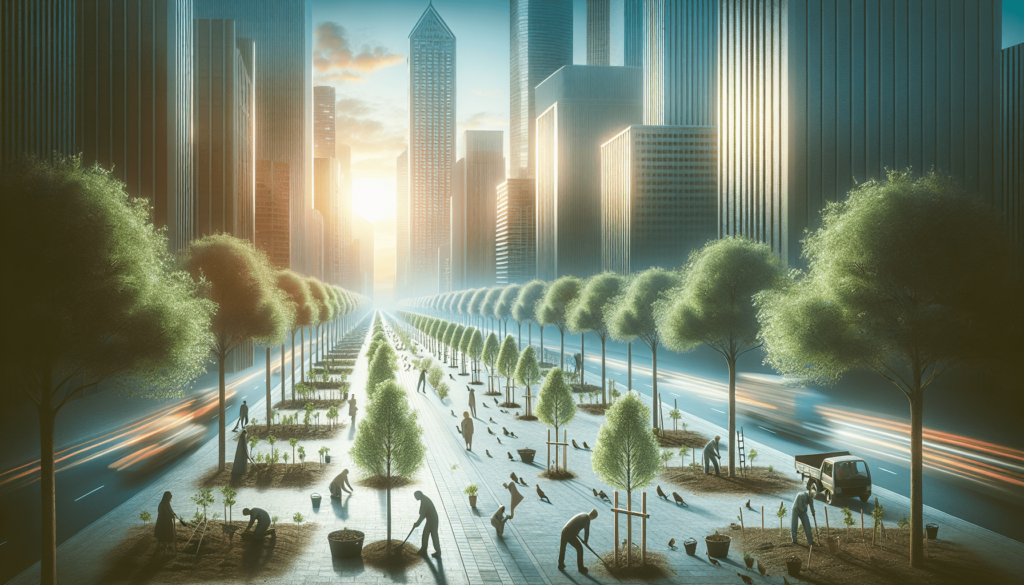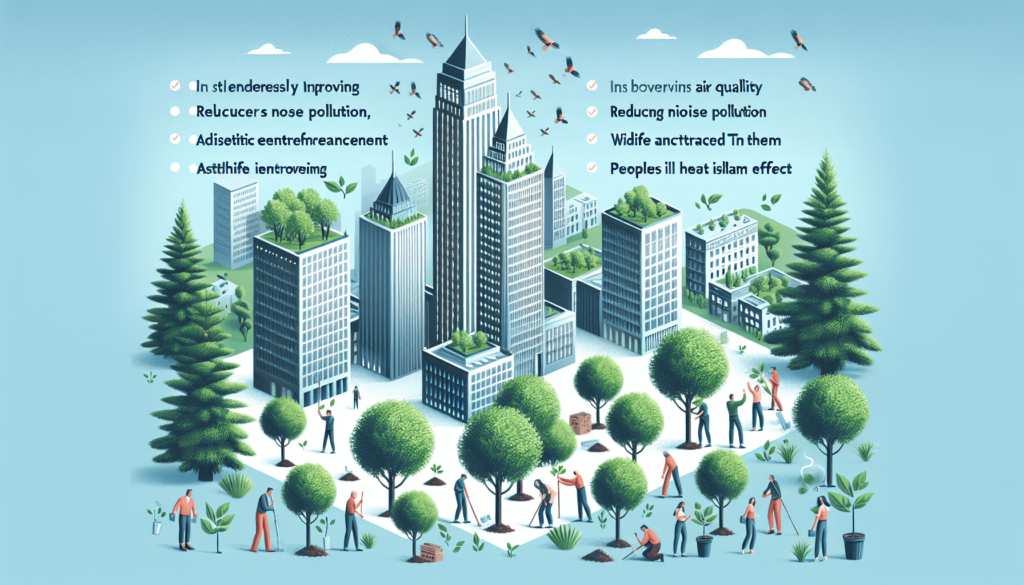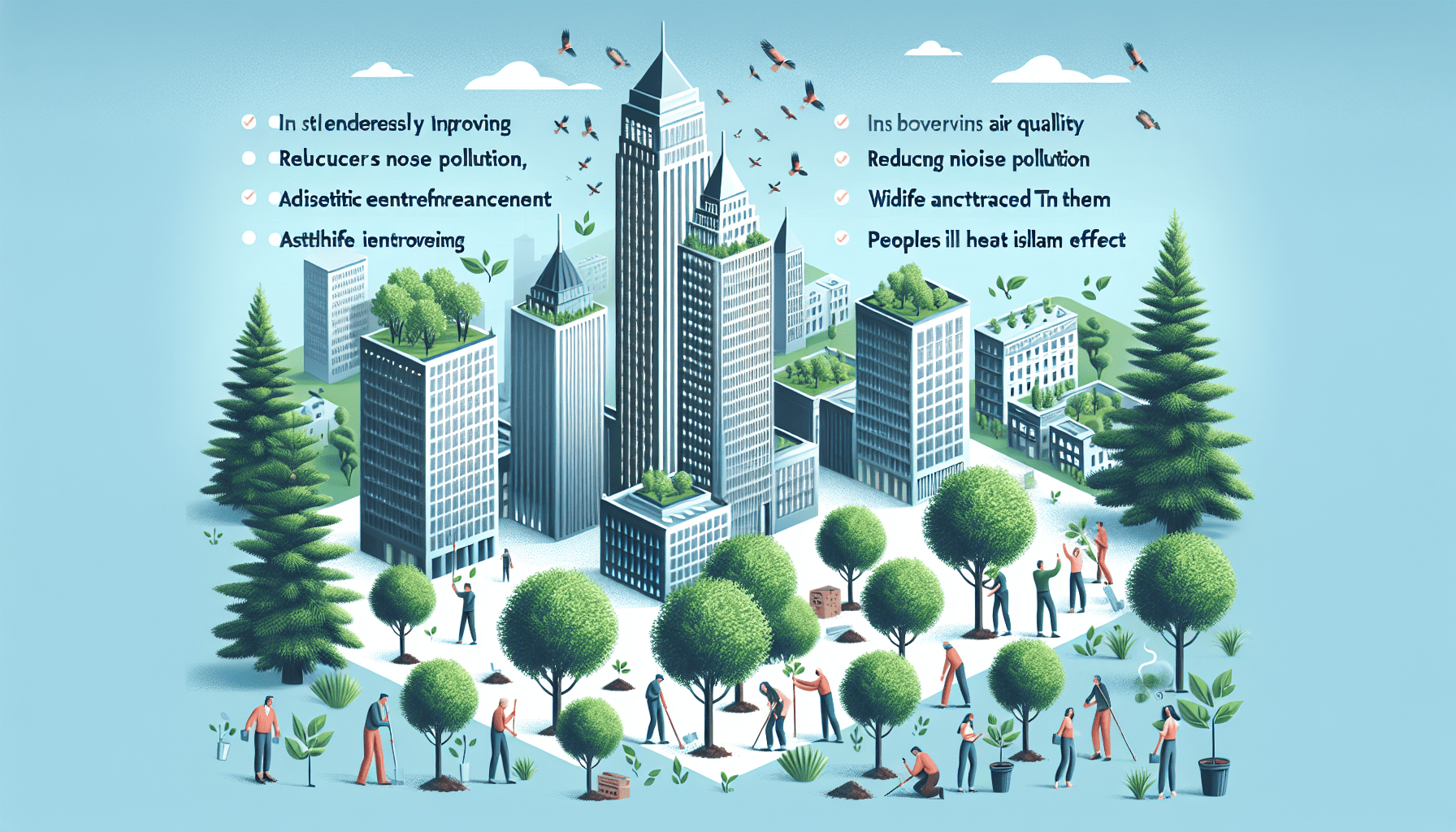Did you know that urban tree planting can have a multitude of benefits for both the environment and the community? Not only do trees enhance the beauty of urban areas, but they also improve air quality, reduce noise pollution, and provide shade and cooling effect. Additionally, urban tree planting has been shown to increase property values and promote physical and mental well-being. In this article, we will explore the various advantages that come with planting trees in our cities and why it is a worthwhile endeavor for a greener and healthier urban environment.

Improved Air Quality
Trees absorb pollutants
Urban tree planting has numerous benefits, and one of the most significant advantages is the improvement of air quality. Trees play a crucial role in absorbing pollutants from the air, such as carbon dioxide, ozone, nitrogen dioxide, and particulate matter. By doing so, they effectively cleanse the air we breathe, creating a healthier environment for everyone. The leaves of trees act as natural filters, trapping these harmful substances and preventing them from being inhaled by individuals in the vicinity.
Reduce air temperature
In addition to absorbing pollutants, trees also help to reduce air temperature in urban areas. Through a process known as evapotranspiration, trees release water vapor into the atmosphere, which cools down the surrounding air. This cooling effect can be especially beneficial during hot summer months when urban heat islands can raise temperatures significantly. By strategically planting trees in urban areas, we can mitigate the adverse effects of extreme heat and create more comfortable and livable environments.
Filter particulate matter
Urban environments are often plagued by high levels of particulate matter, which is a mixture of solid and liquid particles suspended in the air. These particles can originate from various sources, such as vehicle emissions, industrial activities, and construction sites. Trees act as natural air filters, trapping and filtering out these particulate matter particles from the air, thus improving air quality and reducing the health risks associated with breathing in these pollutants. By planting more trees, we can effectively reduce the concentration of harmful particulate matter and create cleaner and healthier urban spaces.
Climate Regulation
Carbon dioxide sequestration
As concerns about climate change continue to grow, the importance of carbon dioxide sequestration becomes increasingly evident. Trees are nature’s solution to mitigating the effects of excessive carbon dioxide in the atmosphere. Through the process of photosynthesis, trees absorb carbon dioxide and convert it into oxygen, effectively serving as carbon sinks. By planting more trees in urban areas, we can contribute to reducing the concentration of carbon dioxide in the atmosphere and mitigate the greenhouse effect, ultimately helping to combat climate change.
Mitigates urban heat island effect
Urban areas are notorious for their high levels of heat, primarily due to the phenomenon known as the urban heat island effect. This occurs when urban landscapes absorb and retain heat, leading to significantly higher temperatures compared to surrounding rural areas. One effective way to counteract the urban heat island effect is through urban tree planting. Trees provide shade and absorb solar radiation, reducing surface temperatures and lowering ambient air temperatures. By strategically planting trees in urban areas, we can create cooler microclimates, making our cities more comfortable and enjoyable.
Reduces energy usage
The shade provided by trees can greatly reduce energy usage in urban areas. By casting shade on buildings, trees can help to significantly reduce the amount of heat absorbed by structures, thereby reducing the need for air conditioning and saving energy. Additionally, trees can also act as windbreaks, reducing wind speed and heat loss from buildings during cold winter months. By using trees as natural insulation, we can decrease the energy demand for heating and cooling, resulting in lower energy costs and a more sustainable urban environment.
Enhanced Biodiversity
Provides habitat for wildlife
Urban tree planting plays a vital role in enhancing biodiversity within our cities. Trees act as habitat providers for a wide range of wildlife, including birds, insects, and mammals. Their branches, leaves, and trunks offer shelter, nesting sites, and food sources for these creatures, enabling them to thrive in urban environments. By increasing the number of trees in our cities, we provide essential habitat for wildlife, helping to preserve and protect urban biodiversity.
Supports pollinators
Bees, butterflies, and other pollinators play a critical role in the pollination of plants and the production of food. Unfortunately, the habitats of these essential pollinators are shrinking due to urbanization and the loss of natural landscapes. Urban tree planting can help to mitigate this issue by providing valuable food sources, such as nectar and pollen, for pollinators. By planting trees that support pollinators, we can create urban ecosystems that are friendly and welcoming to these important creatures, ensuring the continuation of the pollination process and the sustainability of our food systems.
Increases plant diversity
Plant diversity is crucial for the health and resilience of urban ecosystems. By planting a variety of tree species, we can enhance plant diversity and create a more vibrant and sustainable urban environment. Different tree species attract different types of wildlife and provide varied ecosystem services. From providing food and shelter for birds to hosting beneficial insects and improving soil health, diverse tree species contribute to a balanced ecosystem and ensure the long-term viability of urban landscapes.
Noise Reduction
Absorbs and deflects sound
Traffic noise, construction noise, and other urban sounds can be a major source of annoyance and stress for individuals living in cities. Trees can serve as natural sound barriers, helping to absorb and deflect noise, reducing its impact on nearby areas. The foliage of trees can effectively absorb high-frequency sounds, while the branches and trunks act as physical barriers, deflecting and reducing the transmission of noise. By strategically planting trees along busy roads, near residential areas, and around noisy infrastructure, we can create quieter and more peaceful urban environments.
Creates a barrier to noise pollution
In addition to absorbing and deflecting sound, trees also create a physical barrier to noise pollution. The presence of trees can help to block and disrupt the path of sound waves, preventing them from traveling to surrounding areas. This barrier effect not only reduces the noise levels in the immediate vicinity but also helps to protect neighboring spaces from the negative impacts of noise pollution. By utilizing trees as natural noise barriers, we can create more tranquil and enjoyable living environments for urban dwellers.
Improves quality of life
The reduction of noise pollution through urban tree planting has far-reaching benefits that extend beyond mere tranquility. Living in a quieter environment can significantly improve the quality of life for individuals, reducing stress levels, enhancing relaxation, and providing a sense of calm. Studies have shown that exposure to natural sounds, such as the rustling of leaves or birdsong, can have a positive impact on mental health, improving cognitive functioning and overall well-being. By prioritizing the planting of trees in urban areas, we can create spaces that promote a higher quality of life for residents.

Improved Mental Health
Reduces stress and anxiety
The benefits of urban tree planting extend beyond the physical realm and can greatly impact mental health. Spending time in green spaces, surrounded by trees, has been proven to reduce stress and anxiety levels. The calming effect of nature can help to slow down the mind, lower heart rate, and decrease cortisol levels, contributing to an overall sense of well-being. By incorporating trees into urban landscapes, we provide individuals with accessible natural spaces where they can seek respite, find solace, and improve their mental health.
Enhances psychological well-being
In addition to reducing stress and anxiety, urban tree planting has been found to enhance psychological well-being. Studies have shown that exposure to nature, including trees, can improve mood, increase feelings of positivity, and promote a sense of happiness and contentment. Trees provide a connection to the natural world, offering a sense of serenity and harmony that resonates with individuals on a deep emotional level. By prioritizing the integration of trees into urban environments, we can positively contribute to the psychological well-being of urban dwellers, fostering a healthier and happier population.
Provides a calming effect
The sight and presence of trees can have an immediate and profound calming effect on individuals. Urban environments are often characterized by concrete structures, bustling streets, and a general lack of greenery. By introducing trees into these spaces, we can provide a visual respite from the busy and stressful nature of city life. The colors, textures, and movement of trees offer a natural spectacle that can soothe the mind and evoke a sense of tranquility. The calming effect that trees provide is invaluable in combating the pressures and demands of everyday urban living, allowing individuals to find moments of peace and relaxation amidst the chaos.
Reduced Urban Heat
Shade and evapotranspiration
In the scorching heat of summer, the shade provided by trees becomes a valuable asset. By strategically planting trees in urban areas, we can create shaded areas that offer relief from the intense heat. The shade provided by tree canopies helps to lower surface temperatures and create cooler microclimates. Additionally, trees also contribute to the cooling effect through evapotranspiration, where they release water vapor into the atmosphere, reducing the overall temperature of the surrounding air. By harnessing the natural cooling properties of trees, we can combat the detrimental effects of urban heat and create more livable cities.
Decreased energy demand for cooling
By lowering ambient air temperatures and providing shade, trees can help to reduce the demand for air conditioning during hot summer months. The cooling effect of trees can significantly decrease the reliance on mechanical cooling systems, leading to a decreased demand for energy. This reduction in energy usage not only helps to lower carbon emissions but also reduces the strain on electricity grids during peak times. By planting more trees, we can promote energy efficiency, create more sustainable urban environments, and alleviate the burden on both the environment and our energy resources.
Prevents heat-related illnesses
Extreme heat can have severe health impacts, especially for vulnerable populations, such as the elderly, children, and individuals with pre-existing medical conditions. By incorporating trees into urban landscapes, we can reduce the risk of heat-related illnesses, such as heatstroke and heat exhaustion. The shade provided by trees offers a respite from the sun’s rays, allowing individuals to cool down and avoid excessive heat exposure. Furthermore, the evapotranspiration process of trees contributes to humidity regulation, preventing the air from becoming too dry and reducing the risk of dehydration. By planting trees, we can protect the health and well-being of urban residents during periods of extreme heat.
Improved Water Quality
Trees act as natural filters
Urban runoff can be a significant source of water pollution, carrying pollutants such as chemicals, debris, and sediment into nearby water bodies. Trees play a crucial role in improving water quality by acting as natural filters. Their root systems absorb and trap pollutants, preventing them from entering waterways. Additionally, tree canopies intercept rainfall, reducing the impact of raindrops and reducing erosion. By strategically planting trees in urban areas, we can minimize water pollution, promote the protection of aquatic ecosystems, and improve the overall health of our water resources.
Absorb and retain rainfall
In urban environments, impervious surfaces such as roads, sidewalks, and buildings prevent rainwater from being absorbed into the ground. This leads to increased stormwater runoff, which can overwhelm drainage systems, cause flooding, and carry pollutants into water bodies. Trees can help to mitigate these issues by absorbing and retaining rainfall. Their roots act as natural sponges, absorbing water and allowing it to infiltrate into the soil. By planting trees, we can increase the capacity of urban areas to absorb rainfall, reducing the risk of flooding, and conserving water resources.
Reduce stormwater runoff
By absorbing and retaining rainfall, trees can effectively reduce stormwater runoff in urban areas. This reduction in runoff has numerous benefits for both the environment and human well-being. In terms of environmental benefits, reducing stormwater runoff helps to prevent soil erosion, protect aquatic ecosystems, and maintain water quality. From a human perspective, decreased stormwater runoff means a reduced risk of flooding, which can cause significant damage to infrastructure and disrupt daily life. By incorporating trees into urban landscapes, we can alleviate the pressures of stormwater management and create more resilient communities.
Increased Property Value
Enhances curb appeal
The presence of trees in urban areas has a significant positive impact on property value. Trees enhance the curb appeal of neighborhoods, making them more attractive and visually appealing. A well-maintained tree-lined street or a neighborhood with ample green space is often sought after by homebuyers and can command higher property prices. The aesthetic value that trees provide creates a pleasant environment that residents and visitors can enjoy, making neighborhoods more desirable places to live.
Offers aesthetic value
Beyond enhancing curb appeal, trees offer intrinsic aesthetic value to urban landscapes. The beauty and majesty of trees can transform an otherwise dull and lifeless urban environment into a vibrant and inviting space. Trees provide a range of visual elements, such as diverse foliage, interesting textures, and seasonal changes in color, contributing to the overall visual richness of a city. The aesthetic value that trees bring to urban areas enhances the quality of life for residents and creates a sense of pride in their surroundings.
Attracts potential buyers
The presence of trees in urban areas can attract potential buyers and enhance the marketability of properties. Studies have shown that properties with well-maintained trees and green spaces tend to sell faster and at higher prices. The desirability of a tree-rich environment extends beyond the aesthetic aspect, as trees also contribute to improved air quality, reduced noise pollution, and enhanced mental well-being. Homebuyers are increasingly recognizing the value of these benefits and are willing to pay a premium for properties located in tree-lined neighborhoods. By embracing urban tree planting, cities can attract potential buyers and boost their real estate markets.
Community Cohesion
Promotes social interactions
The presence of trees in urban environments encourages social interactions and strengthens community ties. Parks and green spaces with trees provide gathering places where people can come together, engage in recreational activities, and connect with one another. Picnics under the shade of trees, neighborhood events in tree-lined streets, and outdoor performances in green spaces all foster a sense of community cohesion. Trees create inviting and inclusive spaces that bring people together, breaking down social barriers and promoting a sense of belonging.
Creates a sense of belonging
Trees have the remarkable ability to create a sense of belonging and attachment to a place. The presence of trees in a neighborhood or community contributes to its identity and fosters a sense of pride among residents. It provides a visual anchor that individuals can relate to, and trees that have grown and flourished over time can become iconic landmarks within a city. The sense of belonging that trees evoke creates a stronger connection between individuals and their environment, instilling a sense of responsibility for the well-being and care of their community.
Encourages community engagement
Urban tree planting initiatives can serve as catalysts for community engagement and civic participation. Planting trees often involves collaboration and coordination among residents, local organizations, and municipal authorities. These initiatives bring people together, fostering a sense of collective ownership and pride in their communities. Community engagement in urban tree planting not only results in the physical enhancement of neighborhoods but also strengthens social bonds and improves the overall well-being of residents. By actively involving individuals in tree planting projects, cities can harness the power of community engagement and create stronger, more resilient communities.
Health Benefits
Provides shade and UV protection
The shade provided by trees offers more than just relief from the heat; it also provides protection from harmful ultraviolet (UV) radiation. Prolonged exposure to UV rays can lead to sunburn, premature skin aging, and an increased risk of skin cancer. Trees with dense canopies act as natural sunscreens, filtering out a significant portion of UV radiation. By spending time under the shade of trees, individuals can enjoy the outdoors while minimizing their exposure to harmful UV rays, promoting healthier skin and reducing the risk of sun-related illnesses.
Reduces respiratory illnesses
Air pollution is a major contributor to respiratory illnesses, such as asthma and chronic obstructive pulmonary disease (COPD). Trees play a vital role in reducing air pollution by absorbing harmful pollutants from the air. By improving air quality, trees help to mitigate the risk of respiratory illnesses and promote better respiratory health for individuals living in urban areas. Additionally, the cooling effect of trees helps to reduce the formation of ground-level ozone, a major respiratory irritant. By prioritizing urban tree planting, we can improve respiratory health and contribute to a healthier population.
Improves overall well-being
The health benefits of urban tree planting extend beyond physical health; they also have a positive impact on overall well-being. Studies have shown that spending time in green spaces and being surrounded by nature, including trees, can improve cognitive function, boost mood, and enhance overall mental well-being. The connection to the natural world that trees provide offers a sense of calm and serenity, reducing stress levels and promoting a sense of relaxation. By creating green and tree-filled urban environments, we can improve the well-being of individuals, creating healthier and happier communities.
In conclusion, urban tree planting offers a multitude of benefits that positively impact both the environment and human well-being. From improving air quality and mitigating the urban heat island effect to enhancing biodiversity and reducing noise pollution, trees play a crucial role in creating sustainable and livable cities. The aesthetic, social, and health benefits that trees provide make them invaluable assets in urban landscapes. By investing in urban tree planting initiatives, we can create greener, healthier, and more vibrant cities for generations to come.

